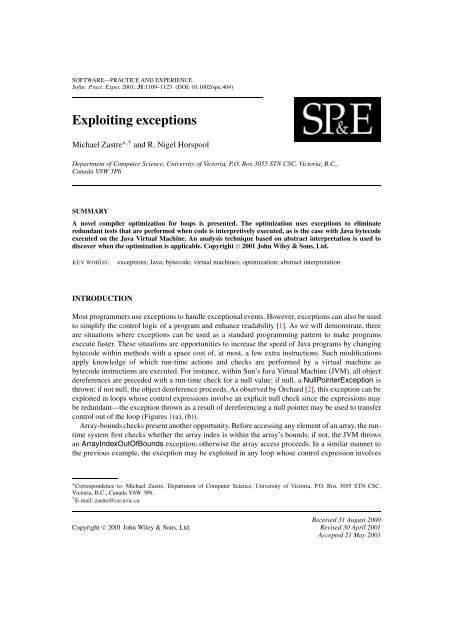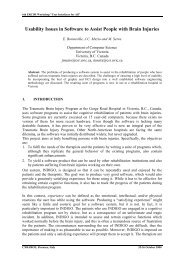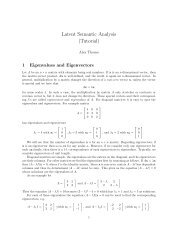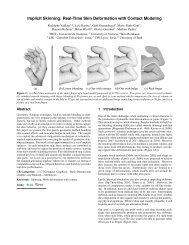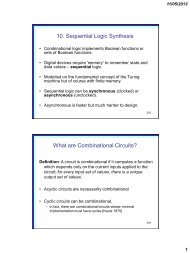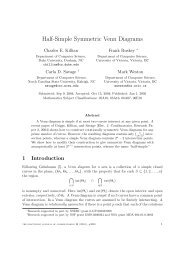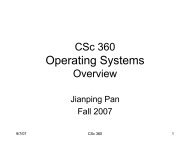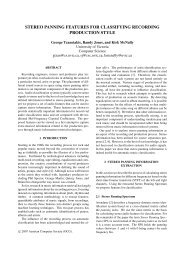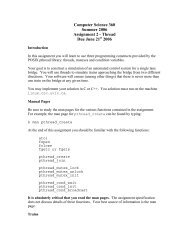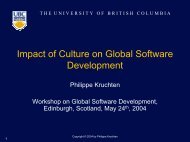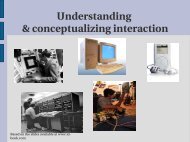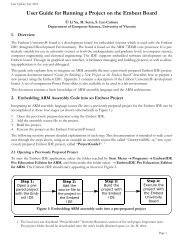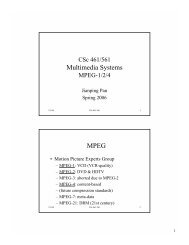Exploiting exceptions - Computer Science, Department of
Exploiting exceptions - Computer Science, Department of
Exploiting exceptions - Computer Science, Department of
- No tags were found...
Create successful ePaper yourself
Turn your PDF publications into a flip-book with our unique Google optimized e-Paper software.
1110 M. ZASTRE AND R. N. HORSPOOLa = 0;p = head;while (p != null) {p = p.next;a++;}return a;(a) originala = 0;p = head;try {for (;;) {p = p.next;a++;}}catch (NullPointerException e) {}return a;(b) transformedFigure 1. Eliminating a redundant null check.i = 0;sum = 0;while (i < A.length) {sum += A[i];i++;}(a) originali = 0;sum = 0;try {for (;;) {sum += A[i];i++;}}catch (ArrayIndexOutOfBoundsException e) {}System.out.println(sum);(b) transformedFigure 2. Eliminating redundant array-bounds check.a comparison between a loop variable and an array’s length. The check may be redundant where thesame action is performed for every array access, and we may use the exception to transfer control out<strong>of</strong> the loop. This eliminates one check on every loop iteration (Figures 2(a), (b)); using Sun’s HotSpotJVM on a 700 MHz Pentium 3, the transformed code is faster than the original code (13 ms vs. 20 ms)when the array is large (A.length > 500 000). The speedup on any JVM clearly depends on the cost <strong>of</strong>throwing an exception and on the number <strong>of</strong> loop iterations.The transformations exploit the termination semantics <strong>of</strong> Java <strong>exceptions</strong>, transferring flow <strong>of</strong>control through the use <strong>of</strong> try-catch statements. Exceptions are subclasses <strong>of</strong> the Java Exception class,and instances <strong>of</strong> <strong>exceptions</strong> are either thrown explicitly via the throw keyword, or implicitly throughthe failure <strong>of</strong> some run-time check. The programmer may use a try-catch statement to specify theexception handler (catch clause) for a specific block <strong>of</strong> code (try clause). When an exception is thrownwithin a try block, the JVM checks if a handler for this exception class exists within a catch block.Copyright © 2001 John Wiley & Sons, Ltd. S<strong>of</strong>tw. Pract. Exper. 2001; 31:1109–1123
EXPLOITING EXCEPTIONS 11110 getstatic #26 // p = head3 astore_04 iconst_0 // a = 05 istore_16 aload_0 // fetch p.next ...7 getfield #31 10 astore_0 // ... and store back in p11 iinc 1 1 // a = a + 114 goto 6 // unconditional goto17 pop // start <strong>of</strong> handler (discard exc. object)18 iload_1 // fetch ’a’ ...19 ireturn // ... and return the valueException table:from to target type6 17 17 Figure 3. Bytecode for Figure 1(b).If so, control is transferred to the first instruction in the catch block; if not, the exception is propagatedto the dynamically enclosing scope where the search is repeated.In Figure 1(a), the loop terminates when p is null, after which the linked list size is returned.The transformed code in Figure 1(b) also terminates when p is null:• the expression p.next dereferences p, so the JVM checks if p is null;• when p is null, the dereference causes a NullPointerException to be thrown;• control is transferred to the catch block for a NullPointerException—in this case, the block isempty;• control continues to the next statement after the end <strong>of</strong> the catch block, in this case the returnstatement;At the level <strong>of</strong> bytecode, an exception table associated with each method contains the informationrepresented by source-level try-catch statements. The bytecode <strong>of</strong> Figure 3 corresponds to thatgenerated for the example in Figure 1(b) (i.e. as would be output from a classfile disassembler such asSun’s javap -c). At the end <strong>of</strong> the code listing is a table having a single row, with numbers referringto statements within the method and a string referring to an Exception class. The first two numberscorrespond to the try-block scope, the third number to the first bytecode <strong>of</strong> the catch block, and theclass name is used at run-time to match <strong>exceptions</strong> with local handlers.The example transformation was applied to Java source code, but may be applied almost as easilyto bytecode. Try and catch blocks may then each be as small as a single bytecode instruction.An advantage <strong>of</strong> working directly with bytecode is access to the goto instruction—a catch block maytransfer control to any other point in the method that is not itself part <strong>of</strong> a catch-block. However, wemust ensure that the expression stack has the correct contents as required by the definition <strong>of</strong> Javasemantics, regardless <strong>of</strong> the control flow introduced by our use <strong>of</strong> goto.Copyright © 2001 John Wiley & Sons, Ltd. S<strong>of</strong>tw. Pract. Exper. 2001; 31:1109–1123
1112 M. ZASTRE AND R. N. HORSPOOLa = 0;p = head;while (p != null) {q = q.next;p = p.next;a++;}return a;(a) originala = 0;p = head;try {for (;;) {q = q.next;p = p.next;a++;}}catch (NullPointerException e) {if (p != null) {throw e;}}return a;(b) transformed with checkFigure 4. Use <strong>of</strong> additional checks in transformed code.Not all loops may be transformed to exploit <strong>exceptions</strong> quite so simply. For instance, if the order<strong>of</strong> increment and dereference statements are reversed in Figure 1(a), then the effects <strong>of</strong> a spuriousupdate would be seen at the print statement in the transformed code, giving an <strong>of</strong>f-by-one error forthe list size. This occurs because the semantics <strong>of</strong> the original code would not be preserved in thetransformed code. Where the original never increments the variable a when p is null, i.e. the loopcontrolexpression evaluates to false, the transformed code instead increments the variable beforethe NullPointerException is thrown and control transferred out <strong>of</strong> the loop. In this latter case, thetransformation is not possible without making other changes to the code.Another instance is where the loop body may also contain a dereference <strong>of</strong> another variable.Any NullPointerException resulting from this dereference must not be consumed by the catch block,but propagated out <strong>of</strong> the block with a throw instruction. Figure 4(a) shows a modification <strong>of</strong> the firstexample: the dereference <strong>of</strong> q might cause a NullPointerException to be thrown. In this instance,the transformed code has an additional check within the catch block to re-throw any unexpectedNullPointerException. Figure 4(b) contains the transformed code with the check in place.Assuming we have performed the necessary code analyses, our algorithm is applied to each programstatement s which tests if an object reference R is null and transfers control if it is.(1) If a statement t in the false program path must throw a null-pointer exception for object R,andifno variables live after t are modified on any program path from s to t, then (a) create a new tryblock enclosing t, and (b) create a new handler <strong>of</strong> the form pop; goto label.(2) If a statement u in the false program path may throw a null-pointer exception for some objectbesides R, and if no variables live after u are modified on any program path from s to u, then(a) find all try blocks introduced in the previous step that also include u and (b) modify thehandler to rethrow the exception if R happens to be not null.(3) Delete all statements s.Copyright © 2001 John Wiley & Sons, Ltd. S<strong>of</strong>tw. Pract. Exper. 2001; 31:1109–1123
EXPLOITING EXCEPTIONS 1113In the next section we present a safety analysis for exploiting the NullPointerException. (Weomitthe analysis required for the ArrayIndexOutOfBounds case, observing that it fits within the frameworkpresented in this paper.) It is followed by a short description <strong>of</strong> the transformation algorithm and anexample. If the cost <strong>of</strong> throwing an exception is less than the total cost <strong>of</strong> evaluating the redundantloop-control expression summed over all iterations, then a speed improvement is the result. A moreefficient implementation <strong>of</strong> <strong>exceptions</strong> would provide such an improvement for any loop iterating asufficient number <strong>of</strong> times; we discuss this following our analysis presentation. We then conclude withsuggestions for further work.CODE ANALYSISOur transformation goal is to remove redundant programmatic null pointer checks from conditionalexpressions while ensuring the meaning <strong>of</strong> the transformed program is unchanged from the original.Sufficient conditions to ensure correctness are that every true program path following the eliminatedcheck• has a dereference <strong>of</strong> the object involved in the expression,• and previous to every dereference contains no assignments to variables which will be used(i.e. live) on some program path leading from the loop, nor contains any method call.The first condition ensures that a transfer <strong>of</strong> control out <strong>of</strong> the loop must occur through a null pointerdereference, and the second ensures that all extra or spurious iterations through the loop body donot change the transformed program’s meaning from the original. A spurious iteration is a (possiblypartial) extra iteration which would not have occurred with the conditional expression in place.We must perform analysis at two program points: that following the true branch <strong>of</strong> a controlexpression involving some null check <strong>of</strong> object p, and that following the false branch. Forthetruebranch we must determine• whether every program path from this point contains at least one dereference <strong>of</strong> p (i.e. theNullPointerException is guaranteed to be thrown when p is null); and• the location <strong>of</strong> object dereferences within the method (i.e. the starting and ending bytecodescorresponding to the try block).For the false branch, we must know• the names <strong>of</strong> all variables whose values are modified on any program path leading from theeliminated expression to the object dereference (i.e. if such a variable is used after loop exit,then the transformed code may have a different meaning from the original code);• whether any operations cause a side effect (e.g. method invocations which would change thevalue <strong>of</strong> some instance or class variable during a spurious iteration); and• whether there are any other objects which may be dereferenced before p’s dereference causes aNullPointerException to be thrown (i.e. must introduce a check within the correct catch block).We can capture the needed information by computing must-ref states, with one state value for eachflowgraph edge (i.e. for each program point). Each state is a set <strong>of</strong> tuples <strong>of</strong> the form(object reference, {instruction number}, {variable name})Copyright © 2001 John Wiley & Sons, Ltd. S<strong>of</strong>tw. Pract. Exper. 2001; 31:1109–1123
1114 M. ZASTRE AND R. N. HORSPOOLFor example, at some program point n, a tuple such as (p, {8, 9}, {p, x, q}) means that• all forward program paths from point n will dereference p;• the first dereference on each path will occur in one <strong>of</strong> statements 8 and 9;• and assignments to p, x and q are the only ones which might occur before the first dereference<strong>of</strong> p.An isnull check <strong>of</strong> an object reference p is considered redundant if p appears as an object referencewithin a state tuple at the program point immediately before the true branch <strong>of</strong> the check, i.e.anisnull check is indeed implicitly performed by the JVM on all true program paths. Then the set <strong>of</strong>variable names is compared against the set <strong>of</strong> live variables at the program point immediately beforethe false branch <strong>of</strong> the check, i.e. a variable is live at a program point if it is used on some programpath starting from that point. If the intersection <strong>of</strong> the two sets is empty, then the transformed programis guaranteed to have the same meaning as the original program. (Note that we refer to programsrather than just loops.) We use the set <strong>of</strong> bytecode positions to either construct a new exception tablefor the method or to modify an existing table—each new row will correspond to a one-bytecodesizedtry block. A catch block is also constructed for each new try block, and simply contains a gotoinstruction to the first instruction <strong>of</strong> the false branch. A developed example is shown in Figures 6and 7.If we know the must-ref state at a point immediately after some statement S, then we can compute themust-ref state immediately before S by using the appropriate rule for each <strong>of</strong> the program statementtypes (e.g. assignment, dereference, conditional branch, unconditional branch, possible side-effect).In terms <strong>of</strong> data-flow analysis, we say that information flows backwards.• Unconditional branch: copies state from successor. If n is the program point preceding someflowgraph node, then succ(n) is the program point immediately following that same flowgraphnode,σ(n) = σ(n ′ ),n ′ = succ(n)• Conditional branches: a meet operation is performed for the must-ref states. We consider thesimple case <strong>of</strong> conditional statements having two branches; multi-way branches are a simplegeneralization. The only tuples which should appear in the resulting state are those whose objectreference appear in both incoming states, i.e. the object will be dereferenced on all outgoingbranches.σ(n) ={(r, l ∪ l ′ ,v∪ v ′ ) |∃(r, l, v) ∈ σ(n 1 ), ∃(r, l ′ ,v ′ ) ∈ σ(n 2 )},n 1 ,n 2 successors to n• Side-effects: our analysis is presented for intra-procedural cases only. Therefore any instructionwhich performs a message send or a results in a side-effect will invalidate the must-ref stateinformation gathered at that program point.σ(n) =∅• Assignments: there are two groups <strong>of</strong> cases—one for the left-hand side <strong>of</strong> the assignment, andanother for the right-hand side. Each group has three sub-cases—pointer dereference, scalarvariable and object reference. One combination may be ignored as impossible, e.g. lhs is a pointerCopyright © 2001 John Wiley & Sons, Ltd. S<strong>of</strong>tw. Pract. Exper. 2001; 31:1109–1123
EXPLOITING EXCEPTIONS 1115reference with rhs a scalar variable. All other combinations transform state by first applying therhs rule to the incoming state, then the lhs rule to this result. We use lhs(n) to refer to the left-handside variable in the statement following program point n; rhs(n) is defined similarly; lnum(n) isthe bytecode position <strong>of</strong> that statement.(1) Any pointer dereference will either generate a new tuple, which must be added to theincoming state, or if such a tuple already exists, will replace the information alreadygathered for that tuple. The lhs and rhs cases have the same rule. A pointer dereferenceis <strong>of</strong> the form r.e, where r is an object reference, and e is a field accessed bydereferencing r.σ(n) ={(r, l, v) | (r,l,v) ∈ σ(n ′ ), rhs(n ′ ) ≠ r.e}∪{(r, lnum(n), ∅) | (r,l,v) ∈ σ(n ′ ), rhs(n ′ ) = r.e},n ′ = succ(n)(2) Any assignment to a scalar or object reference adds to the set <strong>of</strong> variables in all statetuples.σ(n) ={(r,l,v∪ lhs(n)) | (r,l,v) ∈ σ(n ′ )},n ′ = succ(n)(3) If the left-hand side is an object reference, then an alias is introduced, i.e. the lhsobject reference is now aliased to the rhs object reference following the assignment.A null pointer check on the lhs variable is equivalent to a null pointer check on therhs.σ(n) ={(rhs(n ′ ), l, v ∪ lhs(n ′ )) | (r,l,v) ∈ σ(n ′ ), lhs(n ′ ) = r}∪{(r,l,v∪ lhs(n ′ ) | r, l, v) ∈ σ(n ′ ), lhs(n ′ ) ≠ r}, n ′ = succ(n)(4) Finally, the introduction <strong>of</strong> aliasing may also result in a state with more than onetuple having the same object reference. A simplify operation can merge such tuplestogether:{simplify(σ (n)) = (r, λ, δ) | (r, l, v) ∈ σ(n), λ = ⋃ {l ′ | (r, l ′ ,v ′′ ) ∈ σ ′ (n)},δ = ⋃ }{v ′ | (r, l ′′ ,v ′ ) ∈ σ ′ (n)}where σ ′ (n) ={(r, l ′ ,v ′ ) | (r ′ ,l ′ ,v ′ ) ∈ σ(n),r = r ′ }The technique above is a form <strong>of</strong> abstract interpretation [3]. We start not knowing any <strong>of</strong> the must-refstates, but if we initialize all states to empty and repeatedly apply the rules, then we converge to thesolution.Before using must-ref states in a transformation algorithm, we must still account for one othercomplication added by aliasing. Aliasing introduces the possibility that an object dereference, andhence the run-time isnull check, is applied to some object other than the one in the loop-controlexpression. For instance, in Figure 5 the loop-control expression involves an explicit isnull check onp, but one program path from the check to the dereference <strong>of</strong> p has an assignment <strong>of</strong> the form p = q.A null pointer exception thrown at the dereference <strong>of</strong> p may be caused by a null value originating fromeither (1) the object pointed to by p at the start <strong>of</strong> the loop or (2) the object pointed to by q. If the latter,then our catch block must re-throw the exception.Copyright © 2001 John Wiley & Sons, Ltd. S<strong>of</strong>tw. Pract. Exper. 2001; 31:1109–1123
1116 M. ZASTRE AND R. N. HORSPOOLa = 0;while (p != null) {if (s < t) {p = q;}p = p.next;a++;}return a;Figure 5. Aliasing <strong>of</strong> object references.We discover this possibility in our analysis by generating may-ref states for each program point.For example, a may-ref state value such as {(p, {8, 9}, {x}), {q,{8}, ∅)}, at some some program pointn, may be read ason some forward program paths from point n, p may be dereferenced at statement 8 or 9,and q may be dereferenced at statement 8.At statement 8, both p and q may be referenced. Therefore if our analysis indicates that thetransformation is possible, we must add an run-time check for the catch block corresponding to thetry block for statement 8; if p is not null, the catch-block code must re-throw the exception.The construction <strong>of</strong> may-ref states differs from must-refs only in the meet operation for a conditionalinstruction. All tuples in either path must appear in the resulting state.σ(n) = σ(n 1 ) ∪ σ(n 2 ),n 1 ,n 2 successors to nSimilar rules for analysis <strong>of</strong> array-indexed loops are based upon that loops that follow chains <strong>of</strong>references. May-ref states would refer to an (array, index) pair instead <strong>of</strong> singleton reference, andaliasing analysis could be replaced by a induction-variable analysis. In our analyser implementationused to obtain the results reported later, we restricted changes to the easier case <strong>of</strong> the modified mayrefstate.TRANSFORMATION ALGORITHMInput.• Method code with numbered instructions.• Live-variable information where livevar(l) is the set <strong>of</strong> all variables which could be used alongsome program path starting the the program point corresponding to label l.• Abstract state information for each program point n in the method flowgraph.Output.• Modified codeCopyright © 2001 John Wiley & Sons, Ltd. S<strong>of</strong>tw. Pract. Exper. 2001; 31:1109–1123
EXPLOITING EXCEPTIONS 1117Algorithm. For each statement s which tests if object reference R is null, where n is the programpoint corresponding to the true edge, and m is the program point corresponding to the false edge, dothe following:(1) If there exists a tuple (r, l, v) ∈ σ must (n) with r = R and if v ∩ livevar(m) =∅, then:(a) For every line number in l, create a null-pointer exception catch block entry in theexception table such that(i) the try-block start and end labels are both set to l;(ii) the destination is a new globally unique label attached to the following new codesequence ‡(catchlabel): popgoto label(b) For each tuple (r ′ ,l ′ ,v ′ ) in σ may (n) such that r ′ ≠ r and l ′ ∩ l ≠∅,do(i) set check = l ′ ∩ l;(ii) set R to the ObjRef corresponding to r;(iii) for each lnum ∈ check, modify the catch block created in the previous step for thisline number such that it reads(catchlabel): R isnull? goto (newlabel)throw(newlabel): popgoto labelwhere (newlabel) is some globally unique label generated for each lnum in check.(2) Delete statement s.We have some observations regarding bytecode verification and control-flow through finally blocks:• According to Sun’s JVM specification [4], an athrow instruction’s effect on the operand stackis to discard all items below the top item, i.e. the exception object becomes the sole stackcontents. For the transformation to be ‘verifier neutral’ (i.e. not a cause <strong>of</strong> verification failure),no stack item may be live at program point m and at the program point immediately precedings. Here we consider a stack item to be ‘live’ if it is ever popped from the stack. The condition istrivially true at any program point where the stack is empty.• If the transform is applied to bytecode, the semantics <strong>of</strong> code using a finally clause are preservedwithout extra work. For example, a line l could be nested within a try block with a finally clause.Dereferencing a null pointer at l in such a case must take us out <strong>of</strong> the transformed loop withoutexecuting any <strong>of</strong> the finally code. The inserted handler is therefore safe as it transfers control‡ The Java Virtual Machine specification [4] requires that ‘the only entry to an exception handler is through an exception.It is impossible to fall through or ‘goto’ the exception handler’. We can interpret this to mean either (a) even when within anexception handler, code cannot use ‘goto’ to jump to the beginning <strong>of</strong> another handler, nor fall through to an instruction whichhappens to be the start <strong>of</strong> another handler, or (b) once within a handler, code may jump into other handlers without restriction.The first interpretation has been used for this algorithm.Copyright © 2001 John Wiley & Sons, Ltd. S<strong>of</strong>tw. Pract. Exper. 2001; 31:1109–1123
1118 M. ZASTRE AND R. N. HORSPOOLK01: x := 002: read yJ03: p isnull?fI04: x < y?tB10: print yAGtfH05: q := p06: q := rF07: x := x + 1E08: p := p.nextD09: y := q.valCFigure 6. Flowgraph with redundant loop-control expression.directly to program point m after catching the null-pointer exception. This assumes that handlersappear in proper order in the method’s exception table.EXAMPLEIn our example analysis, we examine a method whose flowgraph corresponds to that in Figure 6.The loop contains a conditional expression whose isnull test may be eliminated if(a) all paths from program point corresponding to letter I (n <strong>of</strong> the algorithm) will dereference p,i.e. a null pointer exception thrown by the virtual machine can transfer control out <strong>of</strong> the loop;and(b) all variable definitions occurring after the dereference <strong>of</strong> p do not reach outside the loop,i.e. those defined variables are dead at program point B (m in the algorithm).Copyright © 2001 John Wiley & Sons, Ltd. S<strong>of</strong>tw. Pract. Exper. 2001; 31:1109–1123
EXPLOITING EXCEPTIONS 1119Table I. States for Figure 6.Point must-deref may-derefA ∅ ∅B ∅ ∅C ∅ (p, {8, 9}, {p, x, q, y}), (r, {9}, {p, x, q, y})D (q, {9}, ∅) "E (q, {9}, {p}), (q, {8}, ∅) "F (q, {9}, {p, x}), (p, {8}, {x}) "G (p, {8, 9}, {p, x, q}) "H (r, {9}, {p, x, q}), (p, {8}, {x,q}) "I (p, {8, 9}, {p, x, q}) "J ∅ "K ∅ "If the test may be eliminated, then we must ensure that(c) any null pointer <strong>exceptions</strong> other than those thrown by dereferences to p will not be consumedby the transformed code, i.e. an extra check in the catch block will re-throw the exception ifp isnull? evaluates to false.We use must-deref information to determine (a) and (b), and may-deref information to generate thecheck code required by (c). The values <strong>of</strong> must-ref and may-ref states for each program point areshown in Table I. Since the live-variable set for program point B is equal to {y}, theisnull checkat statement 3 may be eliminated, and the code in Figure 7(b) is the output from the transformationalgorithm.Our present analysis assumes that method calls are treated as side effects, i.e. only intra-proceduralflows are considered. By adding inter-procedural analysis, we expect that more opportunities for thistransformation may be found.COST OF EXCEPTIONSOur goal is to save more time by eliminating redundant loop-control expressions than is spent inthrowing an exception. Much depends upon the relative time cost <strong>of</strong> isnull instructions compared tothe processing <strong>of</strong> throws; in some implementations <strong>of</strong> the Java VM, we have found that throwing andcatching a NullPointerException is from 500 to 4000 times more expensive than executing a simpleisnull check. The high cost can be attributed to several factors.• Depending on the underlying object model implementation, a null-pointer dereference may causea host system null-pointer dereference. In this case, the memory fault is caught by the hostOS—already an expensive operation—and the OS delivers a signal to the process executing theJVM [5].Copyright © 2001 John Wiley & Sons, Ltd. S<strong>of</strong>tw. Pract. Exper. 2001; 31:1109–1123
1120 M. ZASTRE AND R. N. HORSPOOLx := 0read y03 p isnull? goto 10x < y? goto 05q := pgoto 0705 q := r07 x := x + 108 p := p.next09 y := q.valgoto 03x := 0read y03x < y? goto 05q := pgoto 0705 q := r07 x := x + 108 p := p.next09 y := q.val10 print yreturn11 popgoto 1012 p isnull? goto 13throw13 popgoto 10Try-start Try-end Dest Exception------------------------------------08 08 11 nullpointer09 09 12 nullpointer(a) original(b) transformedFigure 7. Original and transformed code for working example.• The method’s exception table must be searched for the proper catch block given the thrownexception’s class. Large exception tables are possible, and the search for a handler is not a simpleequality test. An instance<strong>of</strong> check must be performed since the subclass relationships amongException classes may be non-trivial, i.e. if exception class B is a subclass <strong>of</strong> exception class A,then a thrown instance <strong>of</strong> B could be caught by a handler for A [6].• The Exception class in Java provides a method for printing a stack trace. Therefore, when anexception is thrown, a stack trace must be built at the throw site and stored in the exceptionobject pushed onto the stack. Constructing this trace requires a traversal through the chain <strong>of</strong>stack frames for all methods which have not yet exited, and includes significant other workincluding many lookups into the constant pool. If the exception object is not used, then the effortexpended is lost [7].The systems-programming community has traditionally considered <strong>exceptions</strong> to be rare events,and optimizing their execution in a JVM might be considered as adding needless extra complexity.However, one recent study shows that the exception style <strong>of</strong> programming is becoming more common[1]. Although this particular study is meant to inform implementors <strong>of</strong> optimizing compilers, it also indicatesthe evolving nature <strong>of</strong> typical Java programs and what can be expected to be executed on JVMsCopyright © 2001 John Wiley & Sons, Ltd. S<strong>of</strong>tw. Pract. Exper. 2001; 31:1109–1123
EXPLOITING EXCEPTIONS 1121in the future. Even though our own transformation depends upon runtime (as opposed to user-defined)<strong>exceptions</strong>, there are several simple special cases for which optimizations should exist in a JVM.• Null pointer checks should not depend upon the underlying host system’s memory traps fordetection.• An inexpensive test can be constructed for the simple case <strong>of</strong> an exception thrown within a tryblock where the handler is declared within an accompanying catch block.• The construction at exception-throw time <strong>of</strong> any data structures (e.g. the stack trace) can be donelazily, i.e. as late as possible. For instance, the stack trace could be built incrementally as eachscope is exited.• In many cases, a search <strong>of</strong> the exception table should not be required at run time. Even when itis required, the search can be implemented by table look-up or by perfect hashing.Given these optimizations and where the Exception object is subsequently unused, we confidentlyexpect the cost <strong>of</strong> a NullPointerException to be no more than ten times more expensive than anisnull check. For loops through null-terminated structures, this can result in a speed optimization forloops iterating 100 times or more. We further expect that a faster implementation would help promote<strong>exceptions</strong> as a standard programming pattern.CODE ANALYSIS RESULTSA classfile analyser was written using Purdue’s BLOAT framework [8], and we selected a representativevariety <strong>of</strong> Java packages for our tests. The analyser reads the methods <strong>of</strong> a classfile and then reportsthe number <strong>of</strong> ref-chasing and array-indexing loops; the total such number is reported for eachpackage under ‘all’. The number which are transformable according to our analysis are reported under‘transform’. Results are shown in Table II.Loops that follow chains <strong>of</strong> references appear less <strong>of</strong>ten than array-indexing loops, and the number<strong>of</strong> transformable loops amongst the former is generally smaller than the latter. Ignoring the data forNINJA—a surprise, since numerical code would be expected to make heavy use <strong>of</strong> array indexing—the percentage <strong>of</strong> transformable loops ranged from 16% to 57% for array-indexing and 5% to 52% forreference chains.We observe that our simple analysis rejects loops having a method call on a program path from theloop-condition expression to a suitable runtime-checked instruction. This is too conservative: manymethod calls have no side effects that would invalidate must-ref states (e.g. an append() to a string,clone() on an Object). Beyond modified local variables in a loop, there are other cases involving someglobal variables (i.e. instance and class), and these cases could be enumerated and integrated into theloop analysis at the cost <strong>of</strong> a little complexity.RELATED WORKWe do not know <strong>of</strong> any comparable transformation to that presented in this paper. There is recentwork in analyzing the use <strong>of</strong> exception handling in Java code ([9], [10]) in the context <strong>of</strong> s<strong>of</strong>twareengineering and program analysis (i.e. effect on slicing, building <strong>of</strong> program dependency graphs).Copyright © 2001 John Wiley & Sons, Ltd. S<strong>of</strong>tw. Pract. Exper. 2001; 31:1109–1123
1122 M. ZASTRE AND R. N. HORSPOOLTable II. Classfile loop analysis.Ref-chasing loopsArray-indexing loopsPackage(s) § All Transform All TransformArgoUML 172 86 152 8CUP 5 2 2 0GNU Classpath 176 94 37 5Java2 JRE (rt.jar) 362 190 365 91Jakarta 621 342 248 35HotJava Browser 155 74 87 22NINJA 2 0 0 0Ozone 287 165 330 42SPECjbb2000 12 2 4 0SPECjvm98 326 91 186 96§ ArgoUML: version 0.81a, UML-based CASE tool; CUP: version 0.10j, LALRparser generator; GNU Classpath: version 0.0.2, open-source implementation<strong>of</strong> essential Java class libraries; Java2 JRE: Linux version 1.2.2, from SDK;Jakarta: packages from Apache Java-based web server (ants, tools, watchdog,tomcat); HotJava Browser: version 3; NINJA: IBM’s Numerically INtensiveclass library; Ozone: version 0.7, an open source OBDMS; SPECjbb2000:version 1.01, Java Business Benchmark; SPECjvm98: version 1.03.There is also recent work in eliminating the overhead <strong>of</strong> null-pointer and array-bounds checks for Javamulti-dimensional arrays when used in computationally intensive tasks [11], but this focuses on theimplementation <strong>of</strong> a specially-tuned Array class. The growing body <strong>of</strong> work on Java Just-In-Time (JIT)compilers [12] includes some remedies for the constraints placed upon code-motion optimizations bythe precise-exception semantics <strong>of</strong> Java [13], but these do not address the cost <strong>of</strong> throwing and handling<strong>exceptions</strong>. Advice for Java programmers concerned about program performance in the presence <strong>of</strong>exception handling is also now making its way into programming practitioners’ literature [14].Several research efforts have specifically addressed exception-handling costs. Krall and Probstmodified the exception handling mechanism for their CACAO system, and from this obtained freenull-pointer checks [15]. Lee et al. have implemented a JIT which takes advantage <strong>of</strong> local exceptionhandler cases, i.e. handlers for which no stack unwinding is necessary [16]. Both <strong>of</strong> these solutionsdepend upon native code characteristics to achieve performance improvements, and it is not yet clearhow these approaches would contribute to a generally faster handler mechanism within an interpreter.CONCLUSIONSWe have presented a novel loop optimization for Java bytecode which results in faster code running on aJVM, and which does not depend on the use <strong>of</strong> a JIT compiler. It achieves this speedup by eliminatingloop-control expressions which are already implicitly performed by the JVM as part <strong>of</strong> its supportfor the Java language specification. For example, a loop like that shown in Figure 1 is reduced from6 bytecode instructions to 5. The transformation is not limited to loops—the analysis may be applied toCopyright © 2001 John Wiley & Sons, Ltd. S<strong>of</strong>tw. Pract. Exper. 2001; 31:1109–1123
EXPLOITING EXCEPTIONS 1123any control-flow graph where a conditional expression contains some check already performed alongthe execution path followed when the expression evaluates to true.Possibilities for implementing the optimization include performing it as part <strong>of</strong> a class loader sinceonly bytecode is modified. Pr<strong>of</strong>iling data could also be used to determine when the optimization ispr<strong>of</strong>itable. Similarly, two bodies <strong>of</strong> a loop could be generated (one transformed, the other not) and theappropriate loop version selected at runtime based on some dynamic value.An important conclusion is that exception handling can and should be fast. The assumption that theyare rare events is no longer tenable—the increased use <strong>of</strong> the exception-handling style <strong>of</strong> programmingwill lead to <strong>exceptions</strong> being considered a normal programming construct. We can expect programsto throw and catch <strong>exceptions</strong> much more frequently in the future. The analysis and transformationpresented in this paper is one way in which the emerging coding idiom may translate into faster code.ACKNOWLEDGEMENTSThe authors thank Dave Orchard, IBM Pacific Development Centre, for the original observation that loops mayrun faster if exited by catching an exception; John Aycock and Piotr Kaminski at the University <strong>of</strong> Victoria, andJan Vitek at Purdue University, for helpful discussions; and the anonymous referees for their suggestions.REFERENCES1. Ryder BG, Smith D, Kreme U, Gordon M, Shah N. A static study <strong>of</strong> Java <strong>exceptions</strong>. Proceedings <strong>of</strong> the 9th InternationalConference on Compiler Construction (Lecture Notes in <strong>Computer</strong> <strong>Science</strong>, vol. 1781). Springer Verlag: Berlin, 2000;67–81.2. Orchard D. Better performance with <strong>exceptions</strong> in Java. BYTE Magazine; 1998; 53–54.3. Abramsky S, Hankin C. An introduction to abstract interpretation. Abstract Interpretation <strong>of</strong> Declarative Languages,Abramsky S, Hankin C (ed.). Ellis Horwood, 1987; 9–31.4. Lindholm T, Yellin F. The Java (tm) Virtual Machine (2nd edn). Addison-Wesley: Reading, MA, 1999.5. Alpern B et al. The Jalapeño virtual machine. IBM Systems Journal 2000; 39(1):211–238.6. Vitek J, Horspool N, Krall A. Efficient type inclusion tests. Proceedings <strong>of</strong> OOPSLA ’97, Atlanta, GA. ACM Press, 1997;142–157.7. Cierniak M, Lueh G-Y, Stichnoth J. Practicing JUDO: Java under dynamic optimization. ACM SIGPLAN Conference onProgramming Language Design and Implementation, Vancouver, Canada. ACM Press, 2000.8. Whitlock DM. The BLOAT book. Programming for Persistent Systems Research Group, Purdue University.http://www.cs.purdue.edu/homes/hosking/bloat/ [October 1999].9. Sinha S, Harrold MJ. Analysis and testing <strong>of</strong> programs with exception handling constructs. IEEE Transactions on S<strong>of</strong>twareEngineering 2000; 26(9):849–871. ACM Press.10. Robillard MP, Murphy GC. Analyzing exception flow in Java programs. Proceedings <strong>of</strong> the 7th European S<strong>of</strong>twareEngineering Conference and 7th ACM SIGSOFT Symposium on the Foundations <strong>of</strong> S<strong>of</strong>tware Engineering 1999; 322–337.11. Moreira JE, Midkiff SP, Gupta M, Artigas PV, Snir M, Lawrence RD. Java programming for high-performance numericalcomputing. IBM Systems Journal 2000; 39(1):21–56.12. Sarkar V. Optimizing compilation <strong>of</strong> Java programs. ACM SIGPLAN Conference on Programming Language Design andImplementation, Vancouver, Canada, 2000. Tutorial notes.13. Gupta M, Choi J-D, Hind M. Optimizing Java programs in the presence <strong>of</strong> <strong>exceptions</strong>. Proceedings <strong>of</strong> the 14th EuropeanConference on Object-Oriented Programming (ECOOP), Cannes, France (Lecture Notes in <strong>Computer</strong> <strong>Science</strong>, vol. 1850).Springer Verlag: Berlin, 2000.14. Shirazi J. Java Performance Tuning. O’Reilly, 2000.15. Krall A, Probst M. Monitors and <strong>exceptions</strong>: How to implement Java efficiently. Proceedings <strong>of</strong> the ACM Workshop onJava for High-Performance Network Computing. ACM Press, 1998; 15–24.16. Lee S, Yang B-S, Kim S, Park S, Moon S-M, Ebcioglu K, Altman E. On-demand translation <strong>of</strong> Java exception handlersin the LaTTe JVM just-in-time compiler. Proceedings <strong>of</strong> the Workshop on Binary Translation, October 1999. TechnicalCommittee on <strong>Computer</strong> Architecture (TCCA) Newletter, IEE.Copyright © 2001 John Wiley & Sons, Ltd. S<strong>of</strong>tw. Pract. Exper. 2001; 31:1109–1123


